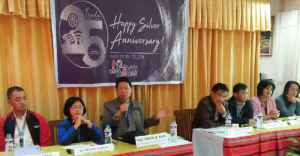DOLE to profile 3,000 child laborers in CAR
BAGUIO CITY — The Department of Labor and Employment – Cordillera Administrative Region (DOLECAR) will profile a total of three thousand (3,000) child workers across the region in an effort to push for more inclusive and preventive interventions in stopping child labor.
DOLE-CAR Regional Director Exequiel Ronie A. Guzman said the 3,000 child laborers who will be profiled in the six (6) provinces namely Abra, Apayao, Benguet, Ifugao, Kalinga and Mt. Province and the City of Baguio will be referred to appropriate agencies which will give them and their families’ assistance.
It was in April 2018 when DOLE launched a nationwide profiling of child laborers and their families in order to better assess their needs so that appropriate interventions could be given.
“Profiling of the child laborers is our strategic way of withdrawing children from child labor and the Regional Office and the Provincial Field Offices will assess their needs and refer these children and their families to appropriate agencies and organizations for the provision of necessary assistance to remove them from child labor,” Guzman added.
He also said parents of the child laborers also received assistance that would enable their families to start their livelihood, which would serve as a preventive measure against child labor.
Another program being implemented by the DOLE is “Project Angel Tree” which would gather from various private sponsors school supplies that would be donated to the children.
Under its 2017-2022 Philippine Development Plan of President Rodrigo Roa Duterte administration aims to reduce the cases of child labor by 30 percent or 630,000 child laborers by the Year 2022.
Basing on the data from the Philippine Statistics Authority (PSA) the number of working children considered as engaged in child labor as defined by Republic Act No. 9231 was estimated at 2.1 million or 63.3 percent of the 3.3 million children 5 to 17 years old. More than half of these children in child labor (58.3%) belonged to age group 15 to 17 years who were part of the labor force population.
Also, more than half of the working children engaged in child labor (58.4%) were in the agriculture sector. Hazardous child labor was estimated at 2.0 million or 61.9 percent of the total working children. Whereas, those in other child labor (around 49 thousand), that is, those children in the age group 5 to 14 years who worked in excess of the allowable work hours comprised 1.5 percent of the working children 5 to 17 years old.
Director Guzman also added that Child labor refers to work situations where children are compelled to work on a regular basis to earn a living for themselves and their families and as a result, are disadvantaged educationally and socially; where children work in conditions that are exploitative and damaging to their health and to their physical and mental development: where children are separated from their families often deprived of educational and training opportunities; and where children are forced to lead prematurely adult lives.
Hazardous work is work which exposes children to physical, psychological or sexual abuse; work underground, under water, at dangerous heights or in confined spaces; work with dangerous machinery, equipment and tools, or which involves the manual handling or transport of heavy loads; work in an unhealthy environment which may, for example, expose children to hazardous substances, agents or processes, or to temperatures, noise levels, or vibrations damaging to their health; (e) work under particularly difficult conditions such work for long hours or during the night or work where the child is unreasonably confined to the premises of the employer.
Patrick Rillorta-DOLE/ABN
Magalong dismayed over “slow progress” in Kennon Road rehab
August 19, 2019
Metro BLISTT
OPERASYON NG JEEPNEY SA BAGUIO, PINAPALAWIG
April 26, 2024
CordINNOVATION
April 26, 2024
OTOP NG CORDILLERA, INILATAG SA MANGAN TAKU FESTIVAL
April 26, 2024
PERA SA BASURA INILUNSAD SA PAGDIRIWANG NG EARTH DAY
April 26, 2024
2008-2021 AUTONOMY SURVEY
April 26, 2024





